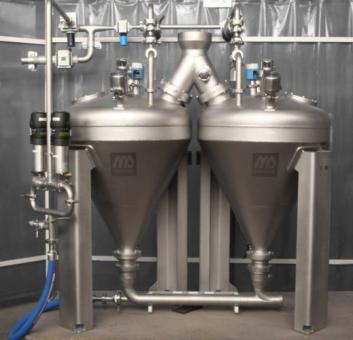This article will discuss:
- The properties that affect pneumatic transport
- The influence of mass, surface, and density of powder particles
- The influence of the surface condition on the transport
- How to avoid collisions
- Moisture, humidity and hygroscopic properties of powder particles
- The influence of fluidization on transport
The experts at Dinnissen Process Technology are available to answer all your questions:
Get in touch with Juul Jenneskens 077 467 3555
The properties that affect pneumatic transport
There are many variables that affect pneumatic transport. The different transport types such as Air Transport and the different types of Dense Phase all have different properties. Different material properties also influence the transport. The choice of transport type is often determined by the properties of the product to be transported. In addition, specific circumstances at the location where the pneumatic transport must be realized are important. Finally, Capex and Opex play a role in the assessment that must be made.
There are many material properties that influence the pneumatic transport. Particle size, impact resistance, mass, volume and surface of the powder particles, moisture content, fat content, solidification temperature of any fat present, hygroscopicity, cohesion, abrasiveness, adhesion and fluidization are all properties that play a role in the choice made.

Dense phase transport
The influence of mass, surface and density of powder particles
The mass and surface of the powder particle affect the transport. The larger the surface of the particle in relation to its mass, the easier it is to transport.
The density of the product to be transported determines the flow properties of the powder. A higher density will reduce the fly properties of the powder. As with the particles with a small surface area, a powder with a higher density will normally not be moved by air transport. The speed required to keep the powder particles flying is then too high. The efficiency is then also very low because a large air volume is required for a small volume of powder. In addition, a denser powder will require more pressure to transport. However, it is unrealistic to say that all powder particles are the same size. Hence, the particle size distribution and the mean particle size are relevant. The greater the difference with respect to the average particle size, the more speed differences can occur. In general, a powder with a narrower particle size distribution is better suited for Dense Phase. The reason behind this is that with the same particle size, the air permeability properties are the same. As a result, the powder will behave more like a unit and thus stays together well. This shows that material density and particle size have an important relationship with each other.
The combination of the size of the powder particle and the density of the powder influence the choice of the transport type. A small density and a small average particle size is ideal for air transport. A higher density and a larger average particle size is ideal for Dense Phase transport.

Mass and density of powders
There are many variables that affect pneumatic transport. In addition to the different transport types such as Air transport and the different types of Dense Phase, which all have different properties, different material properties also influence the transport
The influence of the surface condition on the transport
As mentioned above, the surface area of the powder has an influence on the transport. The surface condition also influences the transport. A porous surface of the powder will have the effect that it is more easily entrained in an air flow. If the pipe walls have a porous surface, this ensures that powder particles will adhere to the pipe walls more quickly. The frictional resistance is then greater.
For air transport, a porous particle surface in a system with smooth pipe walls is ideal. With a powder particle with a smooth surface, the air will flow next to the particle without taking the particle with it. These types of powder particles are less suitable for air transport. Dense Phase transport can transport particles with a smooth and a porous surface. Dense Phase transport can also transport powder through a smooth and a porous pipe.
How can collisions be avoided
The impact resistance is the resistance of the powder to impacts and collisions during transportation. The more brittle the product, the easier it can fall apart in the event of an impact. The speed at which the powder is transported influences the impact force and the number of collisions. Dense Phase is always chosen for a fragile powder. The speed is the lowest and the load factor the greatest. As a result, little or no collisions will occur between the powder and the pipe wall. The collisions that can then still take place will cause less degradation due to the low speed
Moisture, humidity and hygroscopic properties of powder particles
Moisture, relative humidity and the hygroscopic properties of powder particles are an important factor in the possibility of pneumatic transport. With a wetter or fatter powder it is always advisable to use dry air to transport the product. When the air is dry, the powder can be moved with all transport types. However, the relative humidity in the system is more difficult to influence. This depends on the temperature and the pressure. If the humidity becomes too high, the dew point will be reached. At the dew point, water vapor will deposit on the pipe walls and thus wet the powder during transport. Since this point is temperature and pressure dependent, this can be an annoying and difficult problem to overcome. This problem becomes greater if the powder to be transported can naturally absorb water (vapor). The powder is then hygroscopic.
A powder that is wetter has a greater attraction to the walls. This adhesion can cause problems with all transport types. With both Dense Phase and Air Transport, congestion can occur due to excessive adhesion. Air transport is extra sensitive to adhesion. As soon as material deposits on the walls, the Air Transport will slowly silt up. With Dense Phase transport, material deposition does not always have to be a problem. If the pressure can be increased, the material can remain transportable. If the powder is hygroscopic, cohesion can develop in the powder. The absorbed moisture can cause the powder to clump. This increases the density and volume of the particles. The transport properties then change completely. Because the powder particles have already been transported together with Dense Phase, there is no problem here. However, with Air Transport.
Although it seems as if a wetter product cannot or hardly be moved with Air Transport, this is not the case. In a vacuum Air transport, moisture will be a much smaller problem. The pressure is less than one bar, making it more difficult to reach the dew point. If that point is not reached and a dry powder is supplied, moisture will not be a problem. Not even for a hygroscopic powder.
The influence of fluidization on transport
Another important variable is fluidization. Fluidization is the behavior of a bulk solid that behaves like a liquid. This is done with the correct air pressure, good aeration through the powder and the correct particle size and density. It is possible to estimate the fluidization behavior using a Geldert diagram. In the diagram the powders are divided into four areas: A, B, C and D. In the Geldert diagram the density is plotted against the average particle size.
Area A is where the powders of smaller mean particle size and density fall. The powders in area A exhibit more fluid behavior than the other areas. In general, powders in Area A are ideal for Dense Phase transport. This is because of the good fluidization properties. Since the particle size and density are both small, Air Transport is also a good transport system.
Area B contains powders with a larger average grain size and density. These powders will only fluidize if extra systems are used in the transport, such as extra air injectors or extra fluidisation air. That is why these powders can be transported with Dense Phase, if additional facilities are built in for it, and can be transported by air transport, because there is always sufficient air supply there.
Area D contains all powders with a greater density and / or a greater average grain size than the powders in area B. These powders are generally too large or heavy to be transported by air transport. Nor is it ideal to transport this powder Dense Phase due to its poor fluidization properties. Dense phase plug transport, however, is ideal for these types of powders. In plugs with a short length, fluidization plays a less important role, because the length through which the air should pass is shorter than with full Dense Phase and Dune Transport.
The powders in area C are very small and very light. As a result, these powders generally have a high mutual cohesion. As mentioned earlier, powders with high cohesion properties are less suitable for Air transport and more for Dense Phase transport. So in short, area C is more suitable for Dense Phase transport.
The Geldert diagram should be seen as a first indication. It cannot be assumed one on one that a powder falls into an area and can be transported in accordance with these guidelines. This is because the diagram does not take into account the surface of the powder. In addition, it does not take into account the brittleness and quality requirements of the powder. Moisture content and hygroscopic properties of the powder are also not taken into account, but cohesion is taken into account. The properties of the system, such as pipe diameter, roughness and the number of input and output points, are also not reflected in the diagram. The diagram is therefore a good start, but certainly does not provide a definite answer about the ideal transport type, for which there are more variables and factors.
A number of variables are very difficult and not unambiguous to quantify. The variables are all dependent on each other in one way or another and they all affect the transport. As a result, an unambiguous quantification that a powder must ideally meet for each type of transport type cannot be determined. With a theoretical approach, assumptions will always have to be made, so that the results in practice do not correspond with the theory. Due to the large number of factors that have to be taken into account, which also influence each other, the right choice for a pneumatic transport is complex and it is wise to involve specialists.

Name: Juul Jenneskens
Advisor
Please feel free to contact me if you have any questions about this subject. My team of colleagues and I are ready to answer!
Get in touch with Juul Jenneskens 077 467 3555 [email protected]
Do you prefer to request a consultation directly?
